Abstract
This study focuses on addressing the challenges associated with labor-intensive soil penetration resistance (SPR) measurements, which are prone to errors due to varying soil moisture levels. The innovative approach involves developing SPR estimation models using artificial neural networks (ANN) for soils with optimal moisture levels determined by van Genuchten (WG) calculations. Sampling and measurements were conducted at 280 points (0–30 cm depth), with an additional 324 samples used for model testing. Considering six scenarios, this study aimed to identify the best estimation model using key soil properties (sand, clay, silt, bulk density, organic carbon, and aggregate stability) in different combinations affecting SPR. Results from all ANN scenarios demonstrated satisfactory SPR estimation performance, with the sand and clay content scenario exhibiting the highest accuracy, characterized by a mean square error (MSE) of 0.0029 and a coefficient of determination (R2) value of 0.9707. This selected scenario were further validated with different test data, yielding an MSE of 0.7891 and an R2 value of 0.67. In conclusion, this study suggests that, by standardizing moisture levels through WG calculations, ANN-based SPR estimation can effectively be applied to soils with specific sand and clay contents.
1. Introduction
Soil compaction is one of the major problems in modern agriculture in today’s world, especially with the green revolution and increasing mechanization at the end of the 20th century [1,2,3,4]. Particularly in crop production based on traditional tillage, soil compaction problems are quite often encountered as a result of heavy field traffic. In addition, soil compaction is not only a problem in agricultural areas but also occurs as a result of tools and equipment used in pasture areas [5] and forest areas where animals trample, especially during cutting times [6]. Understanding soil compaction characteristics is crucial for sustainable agriculture as it directly impacts root growth, water infiltration, and nutrient uptake, ultimately affecting crop yields. Soil compaction poses a significant challenge for optimizing soil health and ensuring food security. The aim of our study is to predict compaction characteristics. This will enable farmers to implement more effective land management strategies, ultimately contributing to enhanced agricultural productivity and environmental sustainability. One of the most commonly used assessments for determining and monitoring soil compaction is soil penetration resistance (SPR) measurements. It has been determined that SPR, which is one of the most substantial physical quality indicators of the soil, interacts with plant root development, water, nutrient, and air movement in the soil, soil erosion, crop production, and ecological functions [4,7,8,9,10]. Additionally, SPR is the soil property that is evaluated in order to select the appropriate tillage machines and obtain the best tillage time with the lowest energy consumption [11]. For these reasons, knowing the SPR value is among the most important parameters in a sustainable agricultural system. Nonetheless, in addition to the lack of knowledge, experience, and a standard soil penetrometer for SPR measurement among many farmers, experts, and even researchers, measuring SPR in situ is time-consuming and difficult to perform on-site [12]. Thus, many researchers have preferred ways of estimating SPR using pedotransfer functions (PTFs) [13,14,15,16]. Properties such as bulk density (Pb), gravimetric (W), or volumetric (θ) soil moisture content, matric potential (ψ), soil organic carbon content (TOC), macroporosity (MP), and textural soil properties (sand, clay, etc.) are the most frequently used parameters in estimation models [17,18]. However, these PTFs are mostly not tested in the fields and are not highly accurate on fertilization, TOC content, and soil types in different regions. One of the most important reasons for the development of many models is that all these statistical models are PTFs determined according to the soil studied. Despite the fact that the researchers who developed the PTFs said that these models will work in all soil types, it is observed that field conditions trials are few and properties that vary depending on soil type are not used as input parameters [19]. In addition to these, defining the soil compaction with the SPR values read in the field leads to misinterpretations [20,21]. There is a negative relationship between SPR and soil moisture. The lower the soil moisture, the higher the SPR, or vice versa. Furthermore, this situation makes it difficult to compare the data obtained under different conditions with the temporal and spatial changes in soil water content. In order to reduce the effect of soil moisture value on the SPR value, researchers suggested measuring the SPR value close to the field capacity value [22,23] or converting the SPR values measured at different water contents into a fixed SPR with PTF functions [17,24,25,26]. However, the proposed methodologies are still costly due to the need for field sampling and laboratory analysis. Consequently, soil moisture is the most important factor that affects the SPR value of the soil. The soil-water relationship curve (SWRC) is related to soil texture, Pb, and soil physical properties [27]. Many researchers have tried to explain the relationship between SPR and soil moisture and have obtained different outcomes. The results established that the PFTs changed with the change in soil texture, and the functions showed differentiation as tertiary, exponential, and linear [19,28,29]. According to da Silva and Kay [30], obtaining the least limiting water range (LLWR) value by using four different combinations of soil water content, SPR, aeration rate, and Pb parameters ensured the protection of the plant against the SPR-originated negative effects [31]. Moreover, soil moisture during field traffic emerges as an important parameter to determine whether soil compaction is at levels that will limit water and nutrient movement. It does not seem possible to mention a situation limiting water movement in a soil with field capacity. However, as the soil approaches irrigation time, compaction that will affect both nutrient and water intake will lead to productivity losses. Since these changes depend on the alterations in the textural structure of the soil, a constant moisture value needs to be included in the literature regardless of the soil properties. Additionally, soil texture plays an important role in plant growth and environmental health as it affects water movement, solute transport, aeration, and mechanical resistance to root elongation in the soil [32,33]. Recently, the use of artificial intelligence algorithms in determining highly variable situations resulting from complex interactions such as soil compaction has drawn increasing attention [34,35]. In this context, it is observed that the models produced with artificial neural networks (ANN) work with higher accuracy than the regression models [36]. The first use of ANN in SPR estimation was made by Çarman [37], and until today it has been shown that it could be estimated using parameters such as Pb, water content, and total porosity for SPR estimation [1,11,23]. Therefore, the hypothesis to be tested in this study is to establish the SPR estimation with ANN in different scenarios at a constant soil moisture parameter to be determined for areas where traditionally intensive tillage is performed. For this purpose, (1) determining the optimum moisture content of soil samples using van Genuchten PTF SWRC, which changes the soil water content depending on the independent variables; (2) creation of PTF based on measured penetration moisture and volume weight; and (3) calculation of SPR for constant humidity determined using PTF (4) analyzing the SPR prediction sensitivities of different scenarios created by using ANN.
2. Materials and Methods
2.1. Soil Sampling
This study was conducted in the Konya-Cumra plain, where traditional farming methods based on intensive tillage and field traffic were applied. In this study area, wheat and sugar beet cultivation have been carried out intensively for many years, and corn cultivation has also shown significant increases in recent years. A total of 280 sampling and field measurements were performed in this area. This study area is located at the coordinates (37°50′54″ N 32°43′03″ E 37°12′17″ N 33°07′16″ E, UTM, zone 36 N, 1011 m altitude) and is referred to as entisol and inceptisol according to soil taxonomy [38]. Disturbed and undisturbed (0–30 cm) samples were collected at each sample point. Soil samples were collected from plots where sprinkler and drip irrigation were applied, and the same crop rotation and mechanization processes were used. Ten samples were taken from different parts of each field and combined to form a single sample. Disturbed soil samples were taken from each plot, weighing approximately 2 kg. For undisturbed soil samples, steel sampling samples with a height of 50 mm and a diameter of 51 mm were used, and six samples were taken from each field.
2.2. Soil Measurements
The sand, clay, and silt fractions were measured by the hydrometer method [39], wet aggregate (%) using an artificial sprinkler simulator [40], and organic carbon (%) [41] on disturbed soil samples. Soil field capacity (FC) and wilting point (WP) were determined using undisturbed soil cores (for 330 and 1500 kPa). Soil bulk density (g cm−3): these soils were dried at 105 °C for 48 h after they emerged at the wilting point, and it was calculated by dividing the dry weight by the total volume.
SPR measurements were conducted in each land (from 0 to 30 cm depth at 10 replicates) using an Eijkelkamp@ (the operating range is 0–10 MPa [(with a resolution of 0.01 MPa), and the measuring depth is from the surface down to 80 cm vertical resolution of 0.01 m)]. The set of penetrometers used had a cone with a 30° tip angle and a standard cone base area of 1 cm2. The SPR values were recorded in a 1 cm interval down to a depth of 40 cm at an approximated speed of 1 cm s−1. Since SPR is severely affected by soil moisture and field traffic, soil moisture was simultaneously measured in the undisturbed soil samples, and care was taken not to take it from places with field traffic.
2.3. Curve Fitting to the Van Genuchten (WG) Model and Calculations
The biggest problem in comparing the SPRs read in the field with each other is the changes in moisture content. In our study, the coefficients of each (theta r, theta s, alpha α, and n and m) soil were calculated using Equation (1), thanks to the SWRC developed by WG [42]. The RETC program was used for calculations.
where θ is the water content (cm−3 cm−3), θr is the residual water content, and θs is the saturated water content, and where h is the matric potential (kPa), and α, n, and m (m = 1 − 1/n) are empirical parameters [43].
Using the coefficients obtained from these calculations, the optimum tempering moisture content of each soil was calculated by means of Equation (2) [44].
where θopt is the optimum water content (cm−3 cm−3).
2.4. Developing the PFT Function from the PR Values Read
In order to make SPRs a more standardized measurement, the prediction model for SPR was created using Curve Expert version 2.7, using soil properties (Moisture, Bulk weight) that are used the most and affect SPR the most. The Power E model, which gives the highest accuracy (R2 0.85; Figure 1), was chosen for the generated PTF function. The coefficients of the model are given in Equation (3).
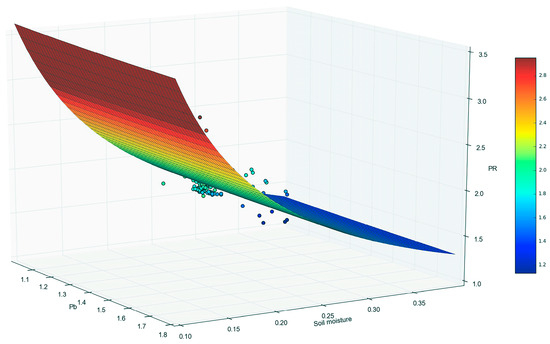
Figure 1.
Graph of PTF obtained using the values of soil moisture content, bulk density, and penetration resistance.
2.5. Developing the ANN Model
In this study, the ANN method, which is used to standardize the most important soil property affecting the SPR value and estimate the effect of other effective soil properties on soil compaction, was utilized. Selected ANN scenarios are given in Table 1. The first 5 scenarios were determined by examining the correlation matrix of the properties, and the 6 scenarios were created by selecting the soil properties with the highest explanation rates as a result of principal component analysis (PCA). ANN was run with 10 varying hidden neurons for each hidden layer to maximize performance (Figure 2). The database consists of a total of 220 samples with 70% calibration, 15% verification, and 15% test data. Moreover, 60 data points were randomly selected from the data set, and these data points were tested without any ANN. In addition, the SPR (total of 324 field readings) results obtained from other studies carried out by the authors in the same region and the results of the project were used as secondary test data, depending on the best scenario to be selected [45,46]. The Matlab program was used for ANN calculations.

Table 1.
Scenarios were created for estimation models.
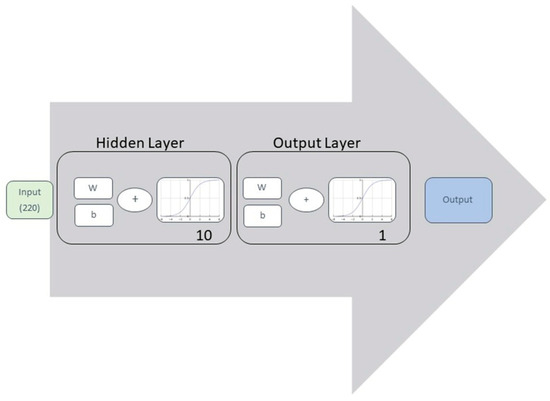
Figure 2.
General structure and process of ANN.
2.6. Model Validation and Performance Measures
Equations (4) and (5) are used to evaluate the performance of artificial neural networks and the different scenarios created. The predictive performance was tested and compared using the mean squared error (MSE) and the determination coefficient (R2).
where n is the number of exemplars of the training set; and are the measured and predicted values of PR.
3. Results
3.1. Descriptive Statistics of the Soil Variables
The statistical results utilized in our study for predicting Soil Penetration Resistance (SPR) and for developing Pedotransfer Function (PTF) models are presented in Table 2. We observed significant variability in the range of properties related to the SPR model parameters of the soils, ensuring both high reliability and broad applicability of the findings from this study. The sand and clay content of the soils varied between 21.40 and 68.90% and between 24.23 and 58.23%, respectively. The coefficient of variation (CV) values of sand and clay content were found to be high. According to the USDA texture triangle, the soils we examined were classified into four categories: clay, sandy clay, clay loam, and sandy clay loam (as illustrated in Figure 3). These soils fall into the medium- and fine textural grades. A review of numerous PTF studies indicates that this range of textural variation is adequate. Further, when comparing our results with other regional soil studies, we found consistency in texture findings (as reported in references [45,46]). The field capacity of the soils at −10 kPa (FC10) and −33 kPa (FC33) tensions and the wilting point (WP) values at −1500 kPa were found to have a mean of 0.394, 0.338, and 0.197 cm−3 cm−3, respectively. The minimum, maximum, and mean values of aggregate stability (AS) were measured as 7.18%, 57.47%, and 27.67%, respectively. Soil organic carbon (OC) varied between 0.238 and 2.394%, and the CV value was found to be 36.89%. When the mean OC value was examined, it was as low [41] as 1.02% and gave similar results to other soils in semi-arid climate regions [29]. The high ranges of variation in OC and AS can be explained by different land use types. OC content is affected by land management (e.g., manure and hay management), in which farmers practice different management practices. The minimum, maximum, and mean values for Pb, which is the most important parameter in PTF estimations for SPR, were found to be 1.09, 1.72, and 1.36 g cm−3, respectively. Capturing such a change in this study area is a result of both processing and textural differences. When the measured PRs were examined, the mean was 1.81 MPa and was found to be very close to 2 MPa, which is limiting for plant growth.

Table 2.
Descriptive statistical results of this study area soil.
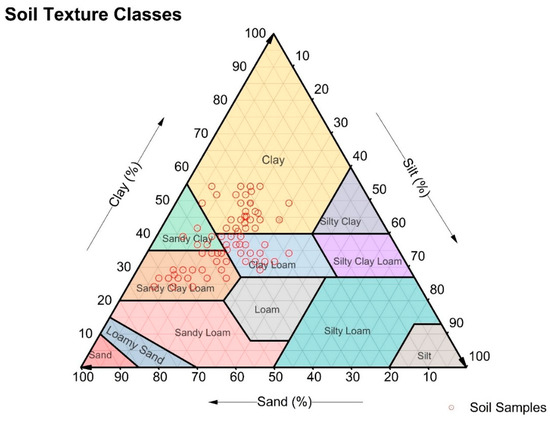
Figure 3.
Textural distribution of Soil Samples.
3.2. Obtained Results for the SWRC Model According
Soil moisture (Θ) in field conditions is the most important factor that affects SPR. In this section, the results of the SWRC parameters determined using the VG formula for each soil are given in Table 3. The results obtained from the calculations show a high CV, except for the coefficient n, which reveals the changes in the soil types of this study. Notably, the alpha (α) coefficient exhibited the widest range of variation among the soils studied. The saturated soil moisture content (Θs) and the residual soil moisture content (Θr) showed variations aligned with the textural differences of the soils, with their means calculated to be 0.465 and 0.071, respectively. The coefficient m required to calculate the optimum moisture content was calculated using the constant (1 − 1/n), and the mean was found to be 0.233. As these parameters are affected by the physical properties of the soils, they can also be calculated under different physical conditions. As a result of these coefficients, the optimum moisture (Θopt) contents of the soils were determined. Θopt varies between a minimum of 0.18 cm−3 cm−3 and a maximum of 0.36 cm−3 cm−3.

Table 3.
Soil moisture parameters were obtained after VG calculations.
3.3. PR Values Corrected for Θopt Content
The estimated SPR values at Θopt moisture content with respect to the nonlinear regression function are given in Figure 4. The SPR values ranged between 1.43 and 2.33 MPa. While 80 of the calculated SPR values vary between 1.58 and 1.73 MPa, values greater than 2 MPa are 30 in total. While the mean of the measured SPR values was 1.81 MPa, the mean Θopt SPR value was determined to be 1.75 MPa. This decrease in the SPR value is an indication that the measurement was made at a humidity higher than Θopt humidity in field measurements.
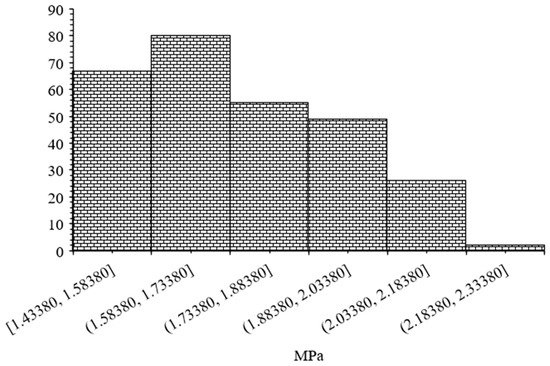
Figure 4.
Distribution of calculated PR values.
3.4. Determination of Scripts According to the Pearson Correlation Coefficients (r) Created and the Results of the PCA Analysis
Pearson correlation coefficients between all variables are given in Figure 5. Upon examining these results, a positive correlation is evident between Soil Penetration Resistance (SPR) and both sand content and bulk density. Conversely, negative correlations are observed between SPR and several other properties: silt, clay, field capacities at −10 kPa (FC10) and −33 kPa (FC33), wilting point (WP), and Organic Carbon (OC). These properties demonstrate significant correlations with SPR. However, Aggregate Stability (AS) did not show any correlation with SPR. The most significant properties affecting SPR are sand, Pb, and clay soil properties. The most important prerequisite for the PCA application to work is a high correlation between the inputs. This correlation needs to be tested by Kaiser–Meyer–Olkin (KMO) and Bartlett’s sphericity test to check whether this study is compatible with PCA or not. In our study, the KMO of 0.764 and significant correlation (p < 0.01) for Bartlett’s test proved a high correlation among the original variables. In order to determine the most dominant characteristics among the soil properties, the PCA test was applied to all the variables determined in Table 2, excluding SPR. PCA results are shown in Figure 6. Three principal components (PC) were determined, which explained 83.92% of the total variance among all soil properties measured. The first of these PCs was determined as sand (PC1), the second as silt (PC2), and the third as AS (PC3). The explanation rates for these selected features were found to be 0.971, 0.824, and 0.964, respectively. In light of these findings, six different scenarios were devised for estimating SPR, detailed in Table 1. The first four scenarios were based on features strongly correlated with PR, while the fifth scenario included the OC feature, recently emphasized in studies. The final scenario incorporated a selection of soil properties identified through PCA analysis.
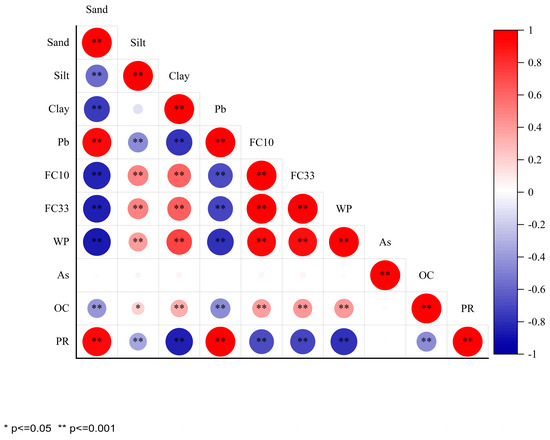
Figure 5.
Distribution of calculated PR values.
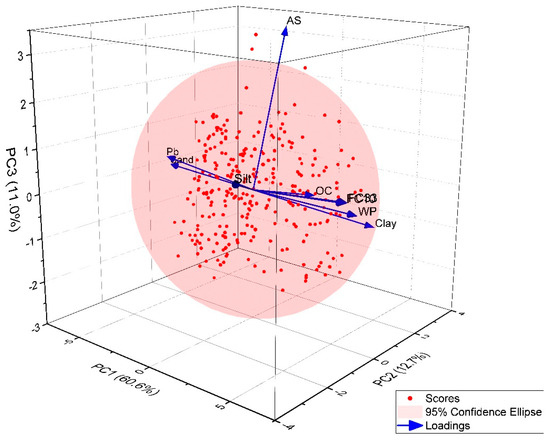
Figure 6.
The result of PCA best represents the explanation of soil properties.
3.5. Prediction of Soil PR Using Neural Networks
In this study, models of six different scenarios were evaluated to obtain the best ANN. Table 4 shows the MSE and R2 values of the ANN results for different scenarios. Except for the scenario made only with clay, the R2 of the test values was found to be above 0.90 in all other scenarios. When the MSE results of the test values are examined, they vary between 0.0003 and 0.109. While the highest R2 value was found in 4 scenarios, the lowest was calculated as 0.91 in 6 scenarios. Despite clay alone decreasing the prediction rate, in the third scenario created with sand, it increased the test validation against only the sand scenario. Six scenarios created with the features selected by PCA receive the second-lowest result in the test data. Whereas sand and clay achieved a high R2 value, the AS value lowered the estimation rate. The results of the features separated from 280 samples and tested without being included in the ANN system are shown in Figure 7.

Table 4.
Performance metrics of ANN for estimation of PR with six different soil data.
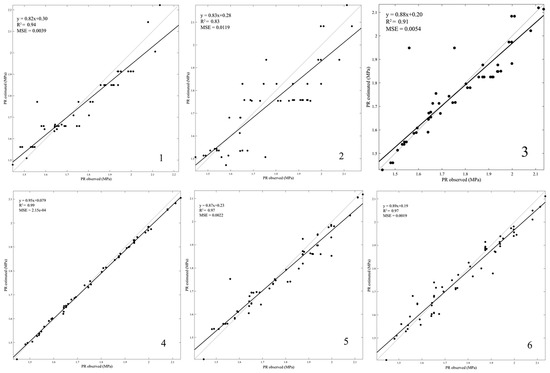
Figure 7.
Results to scatter plots of the ANN model.
When the explanation rates here are examined, the R2 values varied between 0.83 and 0.99. The lowest R2 value is found in scenario 2, while the highest value is seen in scenario 4. On the other hand, when the generated models were applied to the validation data, they obtained statistical coefficients lower than those observed in the model with all samples. In particular, the use of the Pb value in the estimation model increased the high correlation for SPR. According to the sand and clay scenario, four scenarios where Pb was added increased the explanation by 9%. Adding Pb, OC, or AS to estimates derived from texture alone increased the accuracy of the estimation ratios. However, when all scenarios are examined, it is seen that the differences in the test data are not great. In particular, the sand and clay scenarios, which we can name the texture grade, achieved both a high explanation rate (R2 0.91) and a low MSE.
Testing the results obtained from this study with different study data are of great importance in terms of verifying this study. Mean test data for sand, clay, and Pb values are 28.40% (minimum: 5.43%-maximum: 66.40%), 47.39% (minimum: 18.05%-maximum: 79.57%), and 1.31 g cm−3 (minimum: 1.09 g cm−3-maximum: 1.75 g cm−3), and CV values are 50.13%, 13.54%, and 0.12%, respectively. Nevertheless, we did not perform this validation in all scenarios. The second scenario (Sand, clay) that gave the highest explanation rate were tested with this test data, and the results are given in Figure 8. When the results were examined, the coefficient of determination (R2) and the error (RMSE) were calculated as 0.67 and 0.7891, respectively. Despite the fact that the ANN created in light of these data, which are independent from each other, seems low, a verification of about 0.70 shows that it has high generalization.
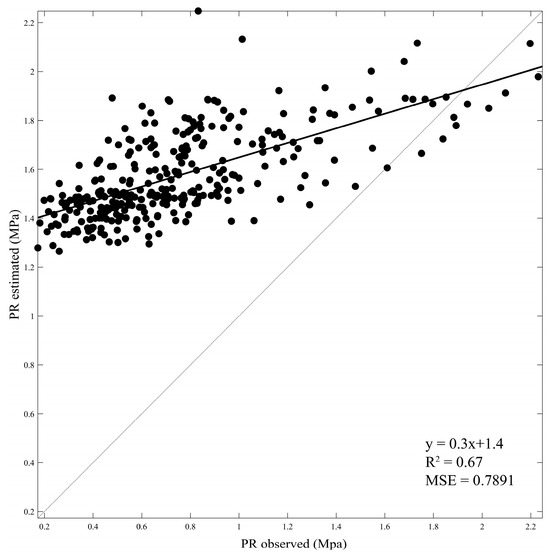
Figure 8.
The results of testing the ANN results obtained with scenario two with test data.
4. Discussion Corrected
In agricultural areas, determining soil compaction is paramount for addressing compacted layers, examining plant root systems, and ensuring suitable cultivation conditions. Soil Penetration Resistance (SPR) plays a vital role in this context, as it not only contributes to reducing fuel consumption through decreased agricultural mechanization but also lessens CO2 emissions associated with fuel use [21]. However, defining and comparing SPR values in the field is challenging due to significant influences from factors such as cost, expertise, and, most importantly, soil moisture [20]. Many PTF studies have been carried out, especially for the standardization of moisture contents [12,47]. In addition, SPR is affected not only by moisture but also by general soil properties such as Pb, OC, and soil texture [48]. In their study, Ayat and Asghari [23] correlated the Critical water content (θc), θs, θf, and n with positive relations with θc and negative relations with Pb, and OC with significant and positive correlations with θs, θf, and n. OC has elastic properties that can reduce the effect of compaction force on soil and consequently reduce soil SPR and Pb [49]. It is well known that due to the increase in OC, the water holding capacity of the soil increases, reducing Pb [50] and forming stable aggregates, all of which reduce soil compaction [51]. Still, soil moisture is the most important property that affects soil compaction and soil mechanical properties. The moisture variation of the soil varies greatly, especially depending on the soil’s mineralogy and texture [48]. To better illustrate these differences, the SWRC is the main element that needs to be defined for each soil. Nonetheless, both time and experts are needed to define SWRC under laboratory conditions. The SWRC provides useful information regarding the water content in the pores in a given soil and the pore size distribution corresponding to the specific pressure condition of the soil [52]. Due to the difficulties and labor costs involved in measuring SWRC, creating estimation equations using currently available data (such as texture, Pb, FC, and WP) are inevitable [53]. The most commonly used method to obtain the SWRC is the application of pedotransfer functions (PTFs). There are many widely used studies that allow estimation of the hydraulic properties of a soil with PTFs, and spatial variations of soil properties can also be ignored [54]. Numerous studies have explored the relationship between SPR and soil water content [27,55], often focusing on specific soil types and utilizing nonlinear equations or moisture stabilization for SPR estimation [16,30]. For example, in the study of Busscher and Bauer [56], the moisture correction performed for light textured soils did not give high accuracy results in heavy-textured soils like our study area. In this case, the creation of PTFs for each soil type and soils with varying spatial characteristics again leads to great confusion of meaning. Therefore, PTF models for SPR estimation with standardized moisture should be generated for each soil type and additionally calibrated for spatial variables [27,55]. With advancing technology, new methods like Artificial Neural Networks (ANNs) are being used for estimating soil mechanical properties. Bayat and Ebrahim Zadeh [29] compare linear and nonlinear regression methods of anns for spr estimation. They found that the ANN method outperforms both nonlinear regression models and other machine learning methods (such as KNN and DLL) [34,57]. The flexibility of ANNs in modeling makes them a promising alternative to traditional PTF functions [58], although their accuracy can vary based on the dataset’s complexity and spatial variability. However, the accuracy of this is debatable. This is because a simple regression model may be an appropriate method in data sets where less sampling and spatial changes are prominent. But when we have nonlinear points and a large dataset, ANN outperforms regression models and achieves better fit and prediction. Many studies have highlighted that soil moisture is a feature that affects the accuracy of models in SPR estimation. Since the root zone of the plant changes according to the plant’s growth, it is necessary to figure out in which zone soil compaction is effective. Soil moisture is affected by factors such as temperature, vegetation, and mechanization. This situation leads to the formation of different moisture levels in the soil profile and, in this case, problems in the interpretation of the SPR [59]. As a consequence, estimating the optimum moisture content with the SWRC developed depending on the soil type makes a great contribution. At optimum humidity, there is no problem with beneficial water for plants, and the most suitable environment for mechanization is provided. The problem of compaction in soils at this humidity level is a great one. In this case, the most valid soil moisture for SPR can be accepted as optimum moisture, and standardizing this moisture allows for a general discussion of soil compaction, ignoring all spatial variation. However, SWRC estimation can only be made from soil texture (sand, silt, or clay). As we did in our study, we calculated Θopt using WG formulas. In this case, it is possible to make SPR estimations of a soil whose texture is known simply by means of ANNs. Bayat, Asghari [23], explained that sand fraction was positively related to Pb, and Moraes, Debiasi [20] clay content affected SPR. de Dios Herrero and Colazo [60] reported that soil texture can affect the soil compaction process. In our study, sand content and ANN estimation gave high results, while clay content gave lower results. However, the scenario in which both were used together had a higher explanation rate than each. The relationship of Pb with SPR is an undeniable fact, and it was observed in this study that choosing this ANN model when Pb was added to the texture scenario resulted in higher prediction accuracy than the others. However, in this case, the necessity of taking degraded soil samples from the fields has emerged. This again requires time and experts. In our study, only the SPR estimation worked with high accuracy, depending on the texture. When the created ANN model is applied to another data set, statistical values are expected to be similar or close [57]. The results, which are not related to our study data set and are due to the evaluation of a large data set during the validation phase, show that the model works with high accuracy.
5. Conclusions
In this study, we observed that the application of Artificial Neural Networks (ANN) in conjunction with methods focusing on soil textural properties yielded effective and promising results for determining Soil Penetration Resistance (SPR) values in crop production areas subject to intensive tillage and field traffic. This approach underscores the potential of utilizing the spatial variability of soil textural properties to identify zones prone to compaction. Consequently, this information can inform management strategies aimed at mitigating the adverse effects of soil compaction.
However, to enhance the accuracy of SPR estimation, further research is necessary. This involves extending these methodologies to diverse soil types and soils under varying management practices. Such an expansion of research scope will contribute to refining and validating the effectiveness of ANN-based approaches in a broader range of agricultural settings.
Funding
This research received no external funding.
Institutional Review Board Statement
This study does not involve humans or animals.
Data Availability Statement
Data are contained within the article.
Conflicts of Interest
The author declares no conflict of interest.
References
- de Lima, R.P.; da Silva, A.R.; da Silva, Á.P. soilphysics: An R package for simulation of soil compaction induced by agricultural field traffic. Soil Tillage Res. 2021, 206, 104824. [Google Scholar] [CrossRef]
- Dörner, J.; Bravo, S.; Stoorvogel, M.; Dec, D.; Valle, S.; Clunes, J.; Horn, R.; Uteau, D.; Wendroth, O.; Lagos, L.; et al. Short-term effects of compaction on soil mechanical properties and pore functions of an Andisol. Soil Tillage Res. 2022, 221, 105396. [Google Scholar] [CrossRef]
- Keller, T.; Sandin, M.; Colombi, T.; Horn, R. Historical increase in agricultural machinery weights enhanced soil stress levels and adversely affected soil functioning. Soil Tillage Res. 2019, 194, 104293. [Google Scholar] [CrossRef]
- Shah, A.N.; Tanveer, M.; Shahzad, B.; Yang, G.; Fahad, S.; Ali, S.; Bukhari, M.A.; Tung, S.A.; Hafeez, A.; Souliyanonh, B.; et al. Soil compaction effects on soil health and cropproductivity: An overview. Environ. Sci. Pollut. Res. 2017, 24, 10056–10067. [Google Scholar] [CrossRef] [PubMed]
- Techen, A.-K.; Helming, K.; Brüggemann, N.; Veldkamp, E.; Reinhold-Hurek, B.; Lorenz, M.; Bartke, S.; Heinrich, U.; Amelung, W.; Augustin, K.; et al. Chapter Four—Soil research challenges in response to emerging agricultural soil management practices. In Advances in Agronomy; Sparks, D.L., Ed.; Academic Press: Cambridge, MA, USA, 2020; pp. 179–240. [Google Scholar]
- Solgi, A.; Naghdi, R.; Marchi, E.; Laschi, A.; Keivan Behjou, F.; Hemmati, V.; Masumian, A. Impact Assessment of Skidding Extraction: Effects on Physical and Chemical Properties of Forest Soils and on Maple Seedling Growing along the Skid Trail. Forests 2019, 10, 134. [Google Scholar] [CrossRef]
- Yang, P.; Dong, W.; Heinen, M.; Qin, W.; Oenema, O. Soil Compaction Prevention, Amelioration and Alleviation Measures Are Effective in Mechanized and Smallholder Agriculture: A Meta-Analysis. Land 2022, 11, 645. [Google Scholar] [CrossRef]
- Zhang, W.; Gao, W.; Ren, T.; Richard Whalley, W. A novel approach to estimate soil penetrometer resistance from water content, bulk density, and shear wave velocity: A laboratory study on a loamy sand soil. Geoderma 2020, 368, 114276. [Google Scholar] [CrossRef]
- Lipiec, J.; Horn, R.; Pietrusiewicz, J.; Siczek, A. Effects of soil compaction on root elongation and anatomy of different cereal plant species. Soil Tillage Res. 2012, 121, 74–81. [Google Scholar] [CrossRef]
- Nunes, M.R.; Denardin, J.E.; Pauletto, E.A.; Faganello, A.; Pinto, L.F.S. Mitigation of clayey soil compaction managed under no-tillage. Soil Tillage Res. 2015, 148, 119–126. [Google Scholar] [CrossRef]
- Massah, J.; Asefpour Vakilian, K.; Torktaz, S. Supervised Machine Learning Algorithms Can Predict Penetration Resistance in Mineral-fertilized Soils. Commun. Soil Sci. Plant Anal. 2019, 50, 2169–2177. [Google Scholar] [CrossRef]
- Wang, H.; Wang, L.; Huang, X.; Gao, W.; Ren, T. An empirical model for estimating soil penetrometer resistance from relative bulk density, matric potential, and depth. Soil Tillage Res. 2021, 208, 104904. [Google Scholar] [CrossRef]
- Busscher, W. Adjustment of flat-tipped penetrometer resistance data to a common water content. Trans. ASAE 1990, 33, 519–0524. [Google Scholar] [CrossRef]
- de Lima, R.P.; da Silva, A.R.; da Silva, A.P.; Leão, T.P.; Mosaddeghi, M.R. soilphysics: An R package for calculating soil water availability to plants by different soil physical indices. Comput. Electron. Agric. 2016, 120, 63–71. [Google Scholar] [CrossRef]
- Khalilmoghadam, B.; Afyuni, M.; Abbaspour, K.C.; Jalalian, A.; Dehghani, A.A.; Schulin, R. Estimation of surface shear strength in Zagros region of Iran—A comparison of artificial neural networks and multiple-linear regression models. Geoderma 2009, 153, 29–36. [Google Scholar] [CrossRef]
- da Silva, A.P.; Kay, B.D. Estimating the Least Limiting Water Range of Soils from Properties and Management. Soil Sci. Soc. Am. J. 1997, 61, 877–883. [Google Scholar] [CrossRef]
- Dexter, A.R.; Czyż, E.A.; Gaţe, O.P. A method for prediction of soil penetration resistance. Soil Tillage Res. 2007, 93, 412–419. [Google Scholar] [CrossRef]
- To, J.; Kay, B.D. Variation in penetrometer resistance with soil properties: The contribution of effective stress and implications for pedotransfer functions. Geoderma 2005, 126, 261–276. [Google Scholar] [CrossRef]
- Whalley, W.R.; To, J.; Kay, B.D.; Whitmore, A.P. Prediction of the penetrometer resistance of soils with models with few parameters. Geoderma 2007, 137, 370–377. [Google Scholar] [CrossRef]
- Moraes, M.T.d.; Debiasi, H.; Franchini, J.C.; Silva, V.R.d. Resistência do solo à penetração em latossolo influenciada pelo tráfego agrícola e o conteúdo de água do solo. Eng. Agrícola 2013, 33, 748–757. [Google Scholar] [CrossRef]
- Fernandes, M.M.H.; Coelho, A.P.; Silva, M.F.d.; Bertonha, R.S.; Queiroz, R.F.d.; Furlani, C.E.A.; Fernandes, C. Estimation of soil penetration resistance with standardized moisture using modeling by artificial neural networks. CATENA 2020, 189, 104505. [Google Scholar] [CrossRef]
- Smith, C.W.; Johnston, M.A.; Lorentz, S. Assessing the compaction susceptibility of South African forestry soils. II. Soil properties affecting compactibility and compressibility. Soil Tillage Res. 1997, 43, 335–354. [Google Scholar] [CrossRef]
- Bayat, H.; Asghari, S.; Rastgou, M.; Sheykhzadeh, G.R. Estimating Proctor parameters in agricultural soils in the Ardabil plain of Iran using support vector machines, artificial neural networks and regression methods. CATENA 2020, 189, 104467. [Google Scholar] [CrossRef]
- Hernanz, J.L.; Peixoto, H.; Cerisola, C.; Sánchez-Girón, V. An empirical model to predict soil bulk density profiles in field conditions using penetration resistance, moisture content and soil depth. J. Terramechanics 2000, 37, 167–184. [Google Scholar] [CrossRef]
- Assouline, S. What Can We Learn from the Water Retention Characteristic of a Soil Regarding Its Hydrological and Agricultural Functions? Review and Analysis of Actual Knowledge. Water Resour. Res. 2021, 57, e2021WR031026. [Google Scholar] [CrossRef]
- Tian, M.; Qin, S.; Whalley, W.R.; Zhou, H.; Ren, T.; Gao, W. Changes of soil structure under different tillage management assessed by bulk density, penetrometer resistance, water retention curve, least limiting water range and X-ray computed tomography. Soil Tillage Res. 2022, 221, 105420. [Google Scholar] [CrossRef]
- Vaz, C.M.P.; Manieri, J.M.; de Maria, I.C.; Tuller, M. Modeling and correction of soil penetration resistance for varying soil water content. Geoderma 2011, 166, 92–101. [Google Scholar] [CrossRef]
- Hummel, J.W.; Ahmad, I.S.; Newman, S.C.; Sudduth, K.A.; Drummond, S.T. Simultaneous soil moisture and cone index measurement. Trans. ASAE 2004, 47, 607–618. [Google Scholar] [CrossRef]
- Bayat, H.; Ebrahim Zadeh, G. Estimation of the soil water retention curve using penetration resistance curve models. Comput. Electron. Agric. 2018, 144, 329–343. [Google Scholar] [CrossRef]
- da Silva, A.P.; Kay, B.D.; Perfect, E. Characterization of the Least Limiting Water Range of Soils. Soil Sci. Soc. Am. J. 1994, 58, 1775–1781. [Google Scholar] [CrossRef]
- Benjamin, J.G.; Karlen, D.L. LLWR Techniques for Quantifying Potential Soil Compaction Consequences of Crop Residue Removal. BioEnergy Res. 2014, 7, 468–480. [Google Scholar] [CrossRef]
- Rabot, E.; Wiesmeier, M.; Schlüter, S.; Vogel, H.J. Soil structure as an indicator of soil functions: A review. Geoderma 2018, 314, 122–137. [Google Scholar] [CrossRef]
- Eck, D.V.; Qin, M.; Hirmas, D.R.; Giménez, D.; Brunsell, N.A. Relating Quantitative Soil Structure Metrics to Saturated Hydraulic Conductivity. Vadose Zone J. 2016, 15, vzj2015.05.0083. [Google Scholar] [CrossRef]
- Yamaç, S.S.; Şeker, C.; Negiş, H. Evaluation of machine learning methods to predict soil moisture constants with different combinations of soil input data for calcareous soils in a semi arid area. Agric. Water Manag. 2020, 234, 106121. [Google Scholar] [CrossRef]
- Alaboz, P.; Dengiz, O.; Demir, S.; Şenol, H. Digital mapping of soil erodibility factors based on decision tree using geostatistical approaches in terrestrial ecosystem. CATENA 2021, 207, 105634. [Google Scholar] [CrossRef]
- Kashi, H.; Emamgholizadeh, S.; Ghorbani, H. Estimation of Soil Infiltration and Cation Exchange Capacity Based on Multiple Regression, ANN (RBF, MLP), and ANFIS Models. Commun. Soil Sci. Plant Anal. 2014, 45, 1195–1213. [Google Scholar] [CrossRef]
- Çarman, K. Prediction of soil compaction under pneumatic tires a using fuzzy logic approach. J. Terramechanics 2008, 45, 103–108. [Google Scholar] [CrossRef]
- De Meester, T. Soils of the Great Konya Basin, Turkey. Agric. Res. Rep. 1970, 740, 290. [Google Scholar]
- Gee, G.W.; Or, D. 2.4 Particle-Size Analysis. In Methods of Soil Analysis; Soil Science Society of America, Inc.: Madison, WI, USA, 2002; pp. 255–293. [Google Scholar]
- Moebius-Clune, B.; Moebius-Clune, D.; Gugino, B.; Idowu, O.; Schindelbeck, R.; Ristow, A.; Van Es, H.; Thies, J.; Shayler, H.; McBride, M.; et al. Comprehensive Assessment of Soil Health: The Cornell Framework; Cornell University: Ithaca, NY, USA, 2016. [Google Scholar]
- Nelson, D.W.; Sommers, L.E. Total Carbon, Organic Carbon, and Organic Matter. In Methods of Soil Analysis; American Society of Agronomy: Madison, WI, USA, 1996; pp. 961–1010. [Google Scholar]
- van Genuchten, M.T. A Closed-form Equation for Predicting the Hydraulic Conductivity of Unsaturated Soils. Soil Sci. Soc. Am. J. 1980, 44, 892–898. [Google Scholar] [CrossRef]
- Mualem, Y. Hydraulic Conductivity of Unsaturated Soils: Prediction and Formulas. In Methods of Soil Analysis; John and Wiley and Sons: Hoboken, NJ, USA, 1986; pp. 799–823. [Google Scholar]
- Dexter, A.R. Soil physical quality: Part I. Theory, effects of soil texture, density, and organic matter, and effects on root growth. Geoderma 2004, 120, 201–214. [Google Scholar] [CrossRef]
- Şeker, C.; Özaytekin, H.H.; Negiş, H.; Gümüş, İ.; Dedeoğlu, M.; Atmaca, E.; Karaca, Ü. Assessment of soil quality index for wheat and sugar beet cropping systems on an entisol in Central Anatolia. Environ. Monit. Assess. 2017, 189, 135. [Google Scholar] [CrossRef]
- Şeker, C.; Özaytekin, H.H.; Negiş, H.; Gümüş, İ.; Dedeoğlu, M.; Atmaca, E.; Karaca, Ü. Identification of regional soil quality factors and indicators: A case study on an alluvial plain (central Turkey). Solid Earth 2017, 8, 583–595. [Google Scholar] [CrossRef]
- Şeker, C. The effect of water content on the penetration resistance of different soils, and regression models. Turk. J. Agric. For. 1999, 23, 467–472. [Google Scholar]
- Vaz, C.M.P.; Manieri, J.M.; de Maria, I.C.; Tuller, M. Scaling the Dependency of Soil Penetration Resistance on Water Content and Bulk Density of Different Soils. Soil Sci. Soc. Am. J. 2013, 77, 1488–1495. [Google Scholar] [CrossRef]
- Aragón, A.; García, M.G.; Filgueira, R.R.; Pachepsky, Y.A. Maximum compactibility of Argentine soils from the Proctor test: The relationship with organic carbon and water content. Soil Tillage Res. 2000, 56, 197–204. [Google Scholar] [CrossRef]
- Bayat, H.; Neyshaburi, M.R.; Mohammadi, K.; Nariman-Zadeh, N. Improving water content estimations using penetration resistance and principal component analysis. Soil Tillage Res. 2013, 129, 83–92. [Google Scholar] [CrossRef]
- Barzegar, A.R.; Asoodar, M.A.; Ansari, M. Effectiveness of sugarcane residue incorporation at different water contents and the Proctor compaction loads in reducing soil compactibility. Soil Tillage Res. 2000, 57, 167–172. [Google Scholar] [CrossRef]
- Fredlund, M.D.; Wilson, G.W.; Fredlund, D.G. Use of the grain-size distribution for estimation of the soil-water characteristic curve. Can. Geotech. J. 2002, 39, 1103–1117. [Google Scholar] [CrossRef]
- Huang, G.-H.; Zhang, R.-D.; Huang, Q.-Z. Modeling Soil Water Retention Curve with a Fractal Method1 1Project supported by the National Natural Science Foundation of China (Nos. 50479011 and 50279025). Pedosphere 2006, 16, 137–146. [Google Scholar] [CrossRef]
- Hodnett, M.G.; Tomasella, J. Marked differences between van Genuchten soil water-retention parameters for temperate and tropical soils: A new water-retention pedo-transfer functions developed for tropical soils. Geoderma 2002, 108, 155–180. [Google Scholar] [CrossRef]
- Zheng, G.; Jiao, C.; Xie, X.; Cui, X.; Shang, G.; Zhao, C.; Zeng, R. Pedotransfer functions for predicting bulk density of coastal soils in East China. Pedosphere 2023, 33, 849–856. [Google Scholar] [CrossRef]
- Busscher, W.J.; Bauer, P.J.; Camp, C.R.; Sojka, R.E. Correction of cone index for soil water content differences in a coastal plain soil. Soil Tillage Res. 1997, 43, 205–217. [Google Scholar] [CrossRef]
- Sargent, R.G. An introduction to verification and validation of simulation models. In Proceedings of the 2013 Winter Simulations Conference (WSC), Washington, DC, USA, 8–11 December 2013; IEEE: Piscataway, NJ, USA. [Google Scholar]
- Merdun, H.; Çınar, Ö.; Meral, R.; Apan, M. Comparison of artificial neural network and regression pedotransfer functions for prediction of soil water retention and saturated hydraulic conductivity. Soil Tillage Res. 2006, 90, 108–116. [Google Scholar] [CrossRef]
- Pias, O.H.d.C.; Cherubin, M.R.; Basso, C.J.; Santi, A.L.; Molin, J.P.; Bayer, C. Soil penetration resistance mapping quality: Effect of the number of subsamples. Acta Scientiarum. Agronomy 2018, 40. [Google Scholar] [CrossRef]
- de Dios Herrero, J.; Colazo, J.C.; Buschiazzo, D.; Galantini, J. Influence of sand gradation on compaction of loess soils. Soil Tillage Res. 2020, 196, 104414. [Google Scholar] [CrossRef]
Disclaimer/Publisher’s Note: The statements, opinions and data contained in all publications are solely those of the individual author(s) and contributor(s) and not of MDPI and/or the editor(s). MDPI and/or the editor(s) disclaim responsibility for any injury to people or property resulting from any ideas, methods, instructions or products referred to in the content. |
© 2023 by the author. Licensee MDPI, Basel, Switzerland. This article is an open access article distributed under the terms and conditions of the Creative Commons Attribution (CC BY) license (https://creativecommons.org/licenses/by/4.0/).